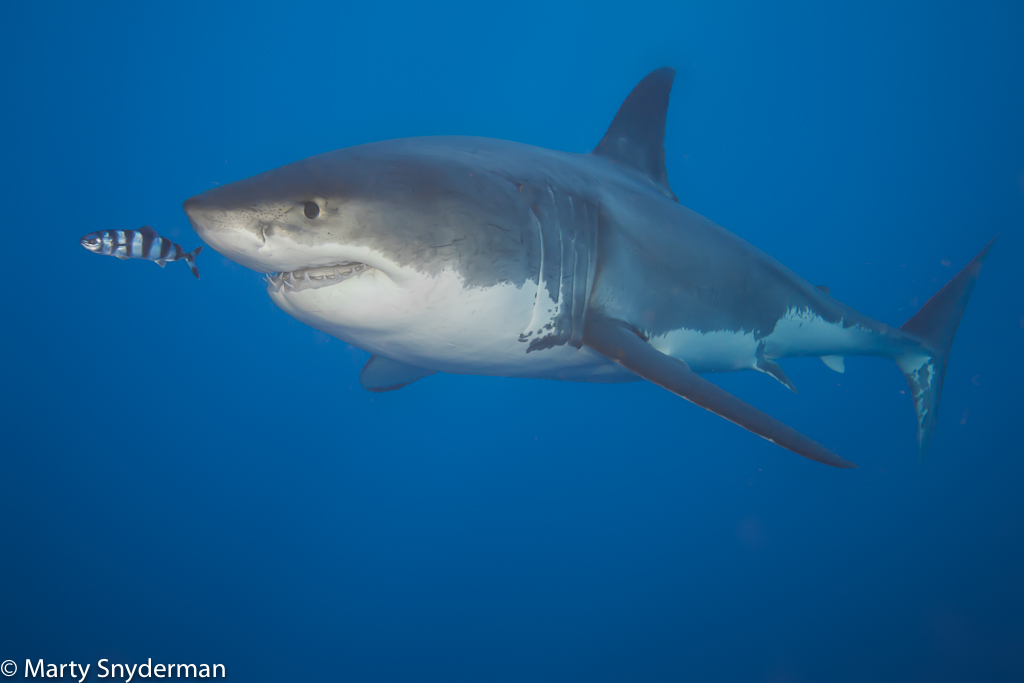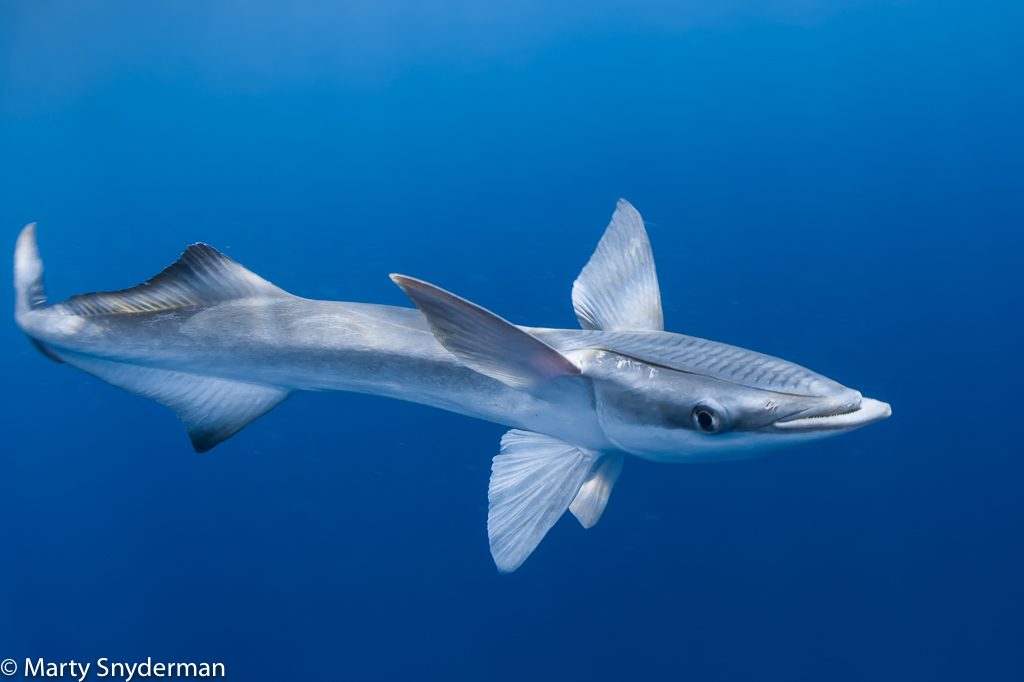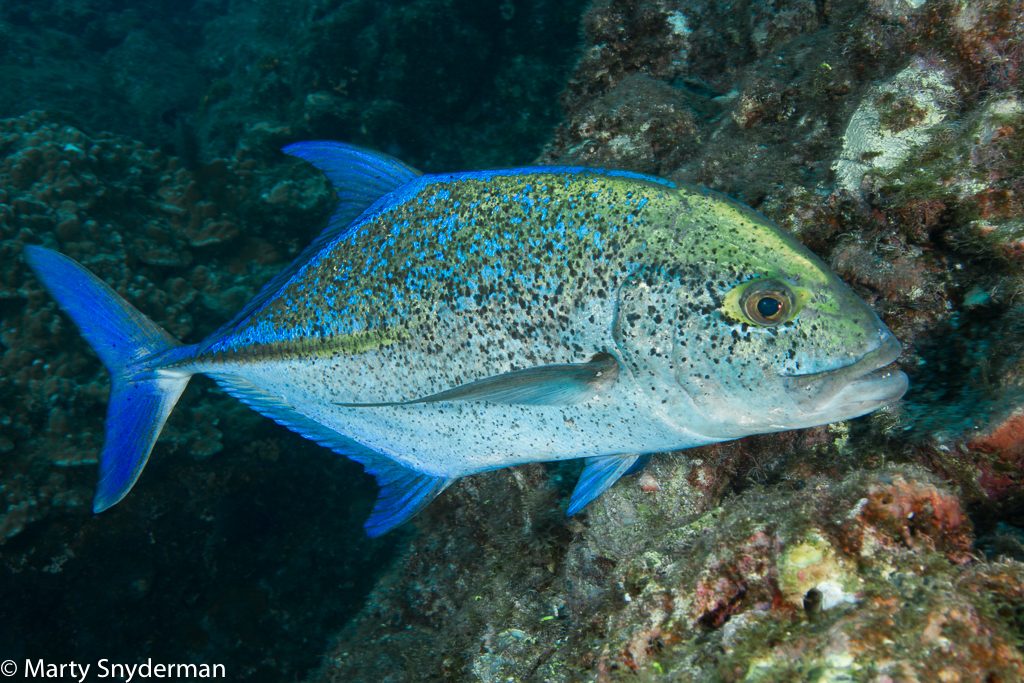Fish That Swim With Sharks
I Swim With Sharks
I Swim With Sharks
©Text and photography by Marty Snydeman

Upon first consideration, it seems like pond or otherwise living in close association with toothy sharks would be the last place you would ever notice smaller fishes. But Mother Nature has other ideas every bit several species of bony fishes including remoras, the rainbow runner, pilotfish, golden trevally and bluefin jack alive in close association to some big fish-eating sharks.
Remoras
The common names remora, diskfish, sharksucker, suckerfish, and hitchhiker fish are all used to label the eight fish species described in the family Echeneidae. Information technology is quite mutual for all of these fishes to adhere themselves to or otherwise accompany a variety of sharks and other larger host animals.
The relationship between remoras and the host animals they accompany is not completely understood. But it is likely that the relationship benefits both the remoras and hosts. The remoras gain protection by associating with large hosts every bit potential predators are likely deterred from pursuing a fish that is attached to the trunk of or pond with a large shark.
Remoras besides benefit by being supplied with food as they are known to feed on a variety of parasites that are found on the pare of their hosts, on scraps of food that they are quick to grab when their hosts capture their prey, and on some organisms that parasitize their hosts. In addition, at least ii species of remoras acquire nutrition by eating the feces of their hosts, a feeding strategy known as coprophagy.
But there is a price to be paid by the remoras as their remains are routinely found in the stomach contents of sharks.
Rainbow Runners
The rainbow runner (Elagatis bipinnulata) inhabits broad segments of offshore and coastal waters in tropical and subtropical seas. Rainbow runners take routinely seen "dive bombing" a number of species of sharks including silkies, gray reef, whitetip reef and blacktip reef sharks every bit these jacks aggressively rub themselves confronting the sharks' crude pare. It is believed that the rainbow runners do so in an endeavor to dislodge parasites from their skin.
Fast swimmers, rainbow runners appear to easily keep step with the sharks. The sharks, on the other hand, often appear to be irritated by the rainbow runners' efforts to rub against them.

Pilotfish
Another jack that routinely swims in close proximity to a variety of open water sharks is the pilot fish, Naucrates doctor. An oceanic species found in tropical and subtropical waters worldwide, pilotfish often tuck themselves in very close to a shark's trunk or fins, and it is not uncommon to see them pond within 1 pes or and so of a shark's snout.
Early on 24-hour interval mariners believed pilotfish led sharks to food, hence their common name "pilot". However, modern scientific discipline suggests that pilot fish take upwards their position as a means of saving energy by swimming in the pressure wave created by a swimming shark. In addition, pilotfish receive the benefit of existence protected confronting an attack from other predators simply because they are swimming and then shut to a potentially menacing shark. And pilotfish sometimes selection upwardly scraps when their host shark makes a kill.
It is likely that the sharks do not benefit from the presence of the pilotfish.
Golden Trevally And Bluefin Jack
Juvenile aureate trevally, Gnathanodon speciosus, are often seen as they swim only a few inches in front of the heads of fish-eating sharks. It is generally accepted that these youngsters gain protection from the mere fact that very few other creatures are probable to try to capture a golden trevally that has a toothy shark as a bodyguard.
The interaction betwixt the bluefin trevally, Caranx melampygus, and whitetip reef shark,Triaenodon obesus, illustrates yet another relationship shared by jacks and sharks. During daylight hours, bluefin trevally unremarkably feeds on the mid-h2o plankton feeders known equally Pacific creolefish. When the marauding jacks blitz the creolefish, the creoles often seek encompass in the latticework of the reef below. The frenetic swimming action often excites the sharks, and they react by trying to pick off confused creolefish. In plow, the jacks benefit from the sharks' pursuit of the creolefish as the further panicked creolefish go easier targets for the jacks.

Fish That Swim With Sharks,
Source: https://ultimatedivetravel.com/i-swim-with-sharks/
Posted by: gentrysaughts1992.blogspot.com


0 Response to "Fish That Swim With Sharks"
Post a Comment